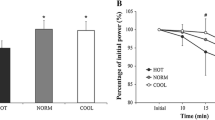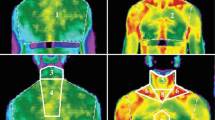Summary
During prolonged exercise in a hot and dry environment one may observe that a man seems to maintain a caloric equilibrium for about one hour. When the man dehydrates, however, a continuous rise in rectal temperature may be observed simultaneously. This discrepancy between calorimetry and thermometry was investigated by measuring calorimetrically the body heat storage during exercise. In a series of experiments work and heat load were kept constant throughout (M=7.5 kcal/min; 35°C; RH 15%), but the exposure time was increased in steps of 18 min up to 144 min. The heat storage did not alter between the 54th and the 108th min. In the same period the rectal temperature rose steadily.
Similar content being viewed by others
References
Gagge, A. P.: Body perspiration on exposure to thermal radiation. Fed. Proc.23, 472 (1964).
—, andJ. D. Hardy: Thermal radiation exchange of the human by partitional calorimetry. J. appl. Physiol.23, 248–258 (1967).
Hardy, J. D.: Physiology of heat regulation and the science of clothingL. H. Newburgh (editor) Chapter 3. Philadelphia-London: W. B. Saunders 1949.
—, andE. F. Du Bois: Basal metabolism, radiation, convection and vaporisation at temperatures of 22°C to 35°C. J. Nutr.15, 477–497 (1938).
Moore, R., andE. R. Buskirk: Science and medicine in exercise and sports.W. R. Johnson (editor) Chapter 11. New York: Harper and Brothers Publ. 1960.
Moroff, S. V., andD. E. Bass: Effects of overhydration on man's physiological responses to work in the heat. J. appl. Physiol.20, 267–270 (1965).
Nielsen, B.: Regulation of body temperature and heat dissipation at different levels of energy- and heat production in man. Acta physiol. scand.68, 215–227 (1966).
Pitts, G. C., R. E. Johnson, andF. C. Consolazio: Work in the heat as affected by intake of water, salt and glucose. Amer. J. Physiol.142, 253–259 (1944).
Robinson, S., F. R. Meyer, J. L. Newton, C. H. Ts'ao, andL. O. Holgersen: Relations between sweating, cutaneous blood flow, and body temperature in work. J. appl. Physiol.20, 575–582 (1965).
Saltin, B., andA. P. Gagge: Muscle temperatures during submaximal exercise. Fed. Proc.27, 232 (1968).
Snellen, J. W.: External work in level and grade walking on a motor driven treadmill. J. appl. Physiol.15, 759–763 (1960).
—: Mean body temperature and the control of thermal sweating. Acta physiol. pharmacol. neerl.14, 99–174 (1966).
Weir, J. B. de V.: New methods for calculating metabolic rate with special reference to protein metabolism. J. Physiol. (Lond.)109, 1–9 (1949).
Winslow, C. E. A., L. P. Herrington andA. P. Gagge: A new method of partitional calorimetry. Amer. J. Physiol.116, 641–655 (1936),
Author information
Authors and Affiliations
Additional information
This article was prepared while holding a research fellowship from the Anglo-American Corporation of South Africa.
Rights and permissions
About this article
Cite this article
Snellen, J.W. The discrepancy between thermometry and calorimetry during exercise. Pflugers Arch. 310, 35–44 (1969). https://doi.org/10.1007/BF00586873
Received:
Issue Date:
DOI: https://doi.org/10.1007/BF00586873




